All illustrations by Felicity Rose Cole
Sodden summers dampen the enthusiasm of many bird- and insect-watchers – but for conchologists they are heaven. Slugs and snails flourish in rainy weather, resulting in sightings of far greater numbers.
Not everyone has a soft spot for these marvellous molluscs, but even keen gardeners ought to spare a moment to marvel at their variety of form. We have pictured 14 species sporting a rich variety of colours and shell shapes.
Many slugs, such as yellow and worm slugs, are strongly associated with people and often frequent gardens and parks. It helps to learn their specific habitat requirements: the tree slug, for example, likes to climb tree trunks, especially in wet weather. The common chrysalis snail slides under ivy and the prickly snail hides in leaf litter.
Mild, damp November nights are ideal for searching for slugs and snails, but you can also look by day under bricks, stones and foliage. So, why not swap your slug pellets for a hand lens?
Great grey slug (Limax maximus , above)
Growing up to a mighty 20cm, this slug is also called the leopard slug due to its dark blotches. It is abundant in gardens and woods, and can climb trees and walls, though the slime trail is not very sticky to touch.
The markings can be quite variable, but dark spots are usually arranged in three dorsal lines. In other variations, the spots look more random, like those of a leopard. Less commonly, some slugs are completely devoid of spots.
Two slugs hang from strings of mucus in order to reproduce in strange mating displays.
Yellow slug (Limax flavus)

This slug can grow up to 10cm and has a yellower colouration than the similar great grey slug, with mottled grey and yellow blotches and bluish tentacles. It can be found in gardens, cellars and outhouses, and can climb walls — it’s comfortable living around people.
The slugs are detritovores, feeding on fungi and rotting dead plants. However, in some areas the slug is outcompeted by the similar Irish yellow slug, which is a duller yellow.
Large black slug (Arion ater)
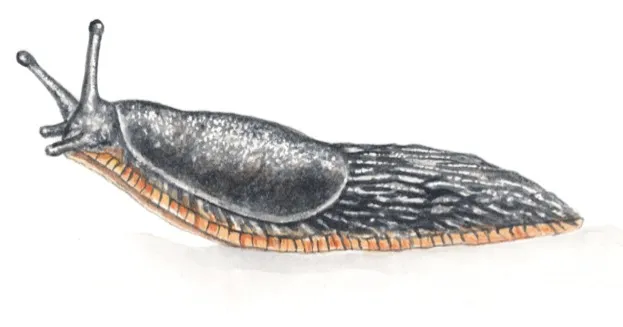
Growing up to about 14cm, large black slugs are typically black with an orange frill (above), but brown, grey and orange forms also occur. The mucus of this group is very sticky. It can also be distinguished by the way it swings from side to side when threatened.
It is resident in gardens and woodland year-round, except winter, and is best seen after rain or at night, when the air is moister. Their spherical, cream-coloured eggs are commonly found in gardens. As it prefers rotting plant matter to living plants, it is not a pest in the garden. It will also eat carrion and dung.
Tree slug ( Lehmannia marginata)

At 8cm, this slug looks rather like a small great grey slug, but the spots are generally elongated, making it look more mottled than the great grey slug. It also has a more stripy appearance, with one predominant lighter stripe along the back.
It is usually found in woods, where it climbs trees – often quite high up – to graze algae and lichen. The specialised diet means that the slug is not a threat to garden plants, but it also means that they are threatened by air pollution and its effect on lichen growth.
Worm slug ( Boettgerilla pallens)

Growing up to 6cm, the worm slug is light greyish or brownish and slender; worm-like. The head is tapered and the slug’s underside is a light yellow. They have a short lifespan, dying soon after egg laying, with new slugs hatching in the wintertime.
It is commonly found in gardens, under bricks or rubbish. The worm slug is an introduced species, first noted in the UK in 1972. It can burrow underground and spends much of its time there, moving through earthworm trails up to 60cm under the surface.
Prickly snail (Acanthinula aculeata)

The shell of the prickly snail is only 2mm across, so a hand lens is needed to examine this species. It is covered in unmistakable prickles. Calcium-rich soils produce the most impressive specimens, but the ornate structures can become damaged over the course of the snail’s life.
It thrives in woodlands and hedgerows, preferring drier habitats than other snails.
Crystal snail (Vitrea crystallin)

This slug’s near-circular shell is 3–4mm across; glassy, and transparent, with regular whorls. It sometimes appears flat on the snail’s back, rather than standing up. Due to its transparency, the grey and darkly streaked digestive gland can be seen through the shell.
It can be found in woods, meadows and road verges, preferring sheltered spaces and avoiding peat soils. It is unlikely to be seen on the soil and more likely to be hidden in shaded leaf litter.
Rounded snail (Discus rotundatus)

Growing only about 5–7mm in diameter, this slug’s shell is circular, with radiating grooves and brown bands. If observed closely, flecks of red can be seen on the shell.
It is very common in woods, gardens and hedgerows, preferring to shelter within stones and logs and on-ground debris (rotting plant matter and fungi). The snails take about a year to reach sexual maturity, from eggs that hatch in February.
Girdled snail (Hygromia cinctella)
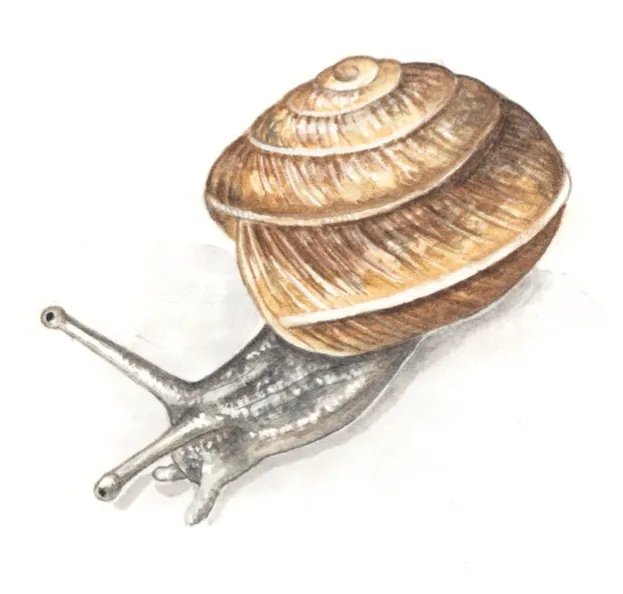
This slug’s shell is roughly triangular, growing to 10–12mm. It is pale to chocolate-brown with a white ‘keel’ – ridge between the whorls.
The snail favours plant nurseries and gardens. It is an introduced Mediterranean species, brought in on garden plants, and is spreading fast. Devon was the first place it was spotted in 1950, but it has seen spread as far as the midlands.
Common chrysalis snail (Lauria cylindracea)

The bulbous shell resembles a moth chrysalis, and is 3–4mm large. It is hard to tell apart from various related snails, but is the most likely to be seen because it is the most common of all of them. Pernickety snail enthusiasts can identify adult specimens by the shell’s white lip and the snail’s single ‘tooth’ – a tooth-like structure at the opening of the shell.
These snails live in gardens, woods and rocky places; often under ivy on walls. It can live in moist to dry habitats.
Common door-snail (Clausilia bidentata)

The elegant shell of this snail can grow up to 12mm. This species is one of several spire-shaped snails found on tree bark or walls. They can be seen at any time of year, but are most likely seen at night or after rain.
They are found in woods and rocky places, where they spend time grazing on algae and lichens. Sometimes, algae bleaches the shell and white grooves appear in its grain.
Plaited door-snail (Cochlodina laminata)
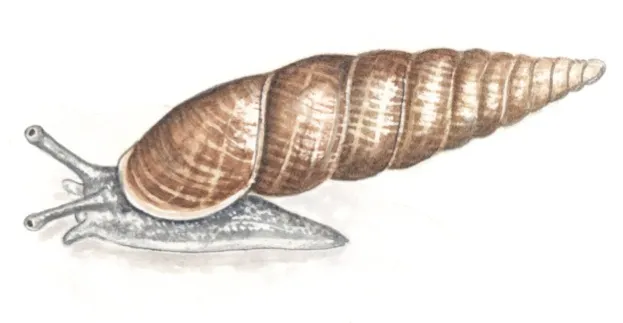
This snail is larger and more robust than Clausilia, with a shell that is 15–17mm and a reddish brown, ‘polished wood’ colour.
They prefer older woods, as well as rocky terrain, feeding on algae and vegetation and climbing trees after rain to reach tasty morsels. Juveniles appear in spring and summer, so mating and egg-laying likely occurs at the beginning of spring.
Garlic snail (Oxychilus alliarius)
6–8mm. Translucent, shiny, pale-brown shell, dark grey body. Emits strong garlic smell when disturbed.
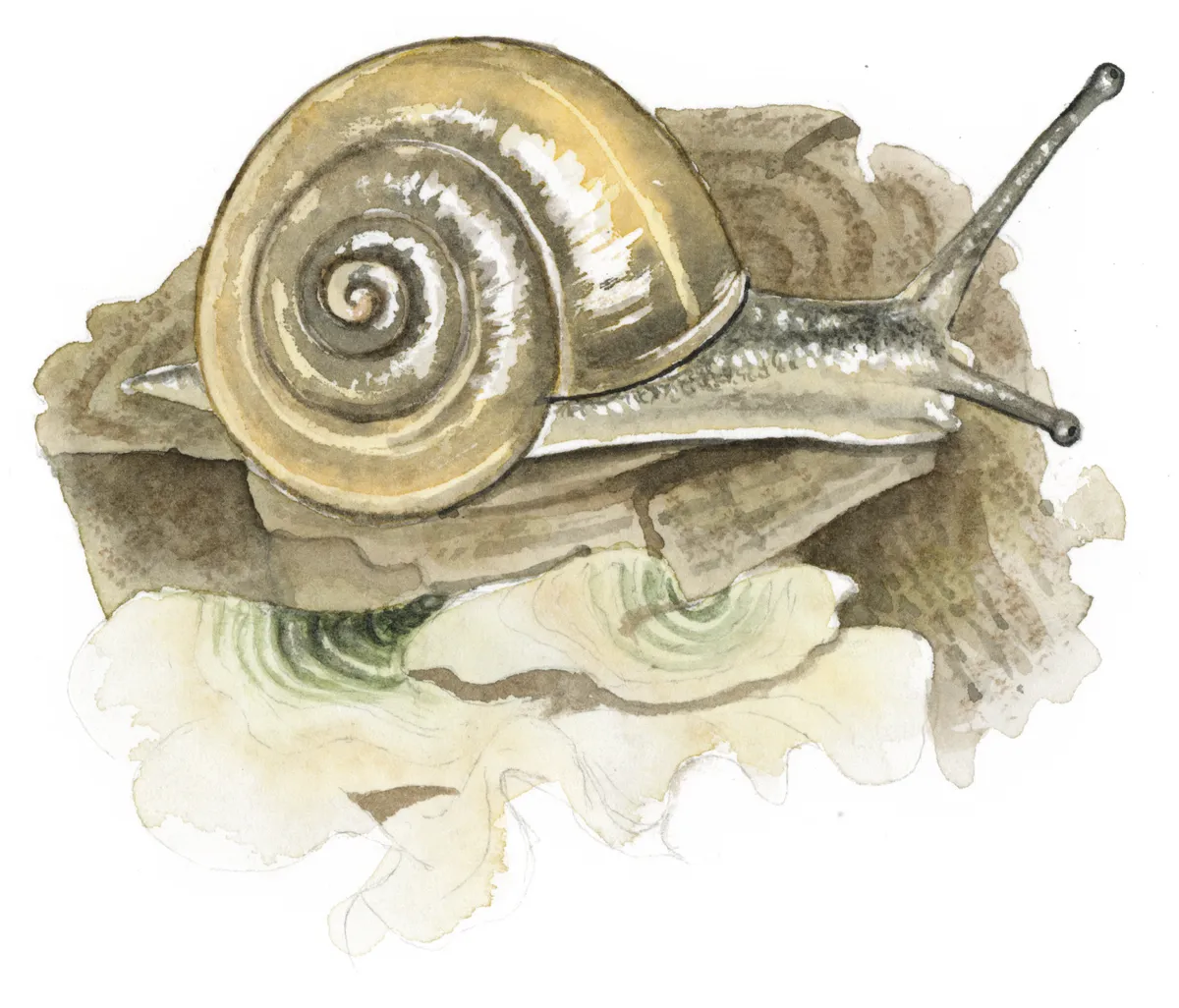
Brown-lipped snail (Cepaea nemoralis)
Variable patterning, but usually yellowish and brown. Always has a dark edge to shell’s inner opening.

Great pond snail (Lymnaea stagnalis)
Grazes algae and rotting matter. The largest pond snail; shell up to 50mm long, tapering sharply.
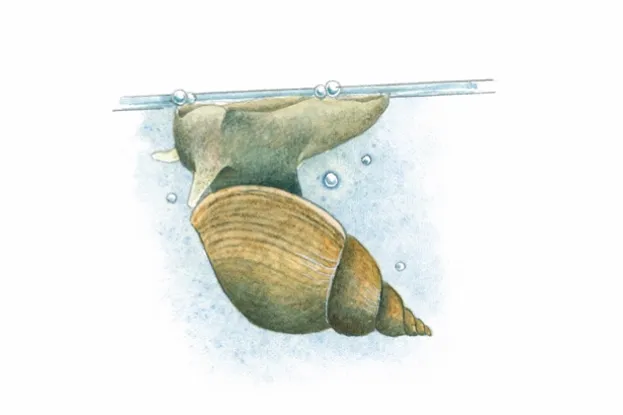
Great ramshorn snail (Planorbis corneus)
Grazes algae and rotting matter. The largest of several similar species; shell 30–35mm across.

How to get involved
- Buy a hand lens to view your finds. A good model is the Triplet Loupe (10x).
- Use the ID key created by the British Conchological Society at conchsoc.org/node/638
- Send records of girdled snails to the society, which is helping to track their spread in the UK.